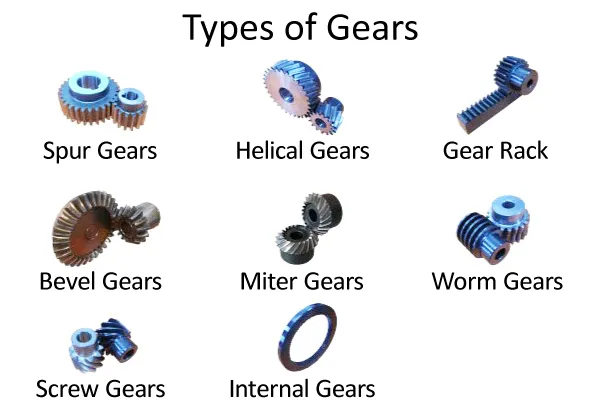Types of Gears

Gears are mechanical components with teeth that mesh with the teeth of another gear to transmit motion and power. They come in various types, each designed for specific applications.
Here are Some Common Types of Gears:
-
Spur Gears:
- Straight teeth parallel to the gear axis.
- Commonly used for parallel shafts to transmit motion and power.
-
Helical Gears:
- Teeth are at an angle (helix) to the gear axis.
- Offers smoother and quieter operation compared to spur gears.
-
Bevel Gears:
- Conical-shaped teeth.
- Used to transmit motion between intersecting shafts.
-
Worm Gears:
- Consists of a worm (screw) and a worm wheel.
- Provides high gear reduction ratios.
-
Planetary Gears (Epicyclic Gears):
- Consists of a central sun gear, planetary gears, and an outer ring gear.
- Used for high torque and compact design.
-
Rack and Pinion:
- Consists of a toothed rack and a pinion gear.
- Converts rotary motion to linear motion (or vice versa).
-
Internal Gears:
- Teeth cut on the inner surface of a cylindrical wheel.
- Used in certain applications where space constraints make external gears impractical.
-
Spur Gear Rack:
- A long spur gear used to convert rotary motion into linear motion.
-
Herringbone Gears (Double-Helical Gears):
- Similar to helical gears but with teeth arranged in a V-shape.
- Reduces axial thrust, providing smooth and quiet operation.
-
Crown Gears:
- Teeth are straight and perpendicular to the gear axis.
- Used for directional changes in motion.
-
Spiral Bevel Gears:
- A type of bevel gear with curved teeth for smoother and quieter operation.
-
Straight Bevel Gears:
- Teeth are straight and have a conical shape.
- Used for intersecting shafts with a 90-degree angle.
-
Face Gears:
- Gear with teeth on the face instead of the periphery.
- Used in applications where precision and smooth operation are critical.
-
Zero-Backlash Gears:
- Designed to minimize or eliminate play between gears.
- Used in applications where precise motion control is essential.
-
Differential Gears:
- Used in vehicles to enable different wheels to rotate at different speeds.
- Allows for smooth turning and traction control.
The choice of gear type depends on the specific requirements of the application, including the desired gear ratio, efficiency, noise level, and spatial constraints. Gears play a crucial role in various machines and mechanical systems for transmitting motion and power.
Thank you.
